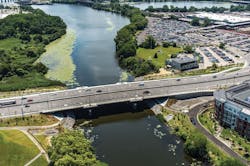Everett and Medford serve as bedroom communities for the city of Boston, and are also industrial and commercial centers in their own right. The Woods Memorial Bridge carries Route 16 over the Malden River which flows into the Mystic River and Boston Harbor beyond. The original bascule drawbridge, constructed in 1954, was replaced by a new 333-ft continuous fixed three-span steel-plate girder superstructure. Multi-column river piers were configured with 3.5-ft diameter columns supported on 4.0-ft diameter drilled shafts. Integral abutments supported on steel piles completed the substructure, making for a “jointless” bridge end to end.
The challenges of working in a marine environment were mitigated by some targeted cooperation between contractors Judlau-White and the Coast Guard and U.S. Army Corps of Engineers.
“The contractor worked off of barges in various stages of the project,” John Hayden, P.E., project engineer for Stantec, told Roads & Bridges, “but for the most part they were able to work with the Coast Guard and Corps to fill in the waterway from the existing banks to the piers, leaving the channel open and free and clear. This allowed them to dismantle existing piers, drill the shafts, and get the new caissons in place. Then they pulled all that fill out and restored the river to its original position.”
Wetland replication, a requirement on a river project like this, could, unfortunately, not take place adjacent to the site; however, a location was employed nearby, which served MassDOT’s requirements.
“Several years ago we were approached by Stantec and MassDOT about creating an additional wetland along the Malden River at River’s Edge as compensation for wetlands MassDOT would be disturbing as part of reconstructing the Woods Memorial Bridge about a half-mile south,” John Preotle, of Preotle, Lane & Associates, said. “Although MassDOT contracting with a private entity to create a wetland was highly unusual for the agency, MassDOT agreed. The wetland was created and works well. In fact a member of the Friends of the Malden River, a local conservation group, said the area adjoining this wetland is her favorite part of the river for canoeing because of the great habitat and hence the many different species of birds.”
The project was brought off in phases: phase 1 saw the build of two bridges and approaches to the north of the existing bridge; phase 2 shifted traffic to the new bridge, demolished the north half of the existing structure, and then built its replacement in place; phase 3 shifted traffic to north once more, allowing the demo of the south half of the bridge, which was subsequently rebuilt; finally, phase 4 built the median and comprised final paving, striping, and landscaping.
Maintenance of traffic was a day-to-day challenge, as MassDOT required a specific number of lanes to remain open throughout operations.
“On the eastbound direction throughout the entire project, we maintained three lanes open at all times,” Hayden said. “On the westbound MassDOT allowed us to take a lane back during the day to construct the project. But we had room on the north side of both bridges to work away from traffic. We built two lanes, did a traffic shift, then demoed the old lanes, rebuilt the bridge in that location, and shifted traffic again. We were fortunate to have the room to divert the traffic to the north during initial phase of the work.”
The project improved access for all users by providing three lanes for through traffic in each direction on the new structures; auxiliary lanes—one in each direction—to provide acceleration and deceleration lanes into and out of the ramps; 8-ft wide shoulders on each side; and 10-ft wide sidewalks on each side. “The sidewalks also tie into a multiuse path network that parallels the roadway and goes under the bridge on both sides of the river, connecting into the East Coast Greenway and the Malden River Greenway,” Hayden noted.
The addition of the auxiliary lanes provided a safe place for vehicles to go when using the ramps, as opposed to slowing down in traffic. The shoulders and wide sidewalks provide a safe and inviting place for bicyclists and pedestrians alike to traverse the project site, going to and from work, shopping, transit, area restaurants, and the new Encore Casino, of which designers said you should not underestimate the importance.
“The Encore Casino that was built a half mile from the bridge is the big news in Everett,” Project Manager John Hendrickson, P.E., told R&B. “It’s a major, major draw.”
And now, it’s much easier to get to.
